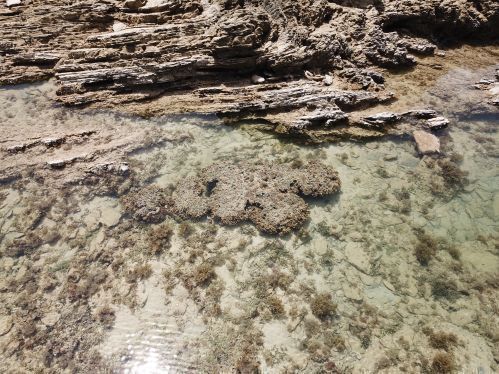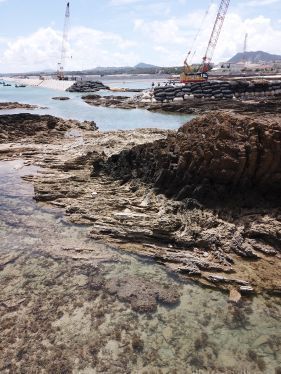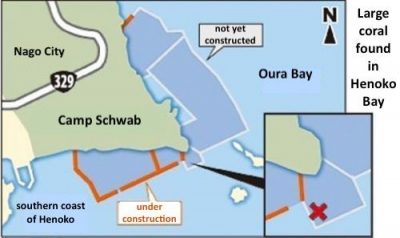MOD insists corals ineligible for transplantation only one month prior to Henoko soil deposits

Coral, likely a colony, off the shore of Camp Schwab in Henoko, Nago City on July 13 around 2:00 p.m. (photograph taken via small drone)
July 17, 2018 Ryukyu Shimpo
According to the Okinawa Defense Bureau’s (ODB) notification to the Okinawa Prefectural Government (OPG), as of July 17 there is one month remaining until the day soil depositing into the ocean begins as part construction of a replacement facility in Henoko, Nago City for Futenma Air Station.
The ocean area in Oura Bay and Henoko is richly abundant in terms of wildlife, with over 5300 species of plants and animals living there.
Since the Japanese government has begun work in the ocean, endangered dugongs have not been observed in the area.
Experts indicate that transplanting large coral found within the planned land reclamation site is essential.
The OPG has requested that the seaweed beds on which dugong feed on and in which smaller creatures live be transplanted.

Colony of coral living in the ocean area planned for land reclamation, near the seawall construction at Cape Henoko on the shore of Camp Schwab in Henoko, Nago at around 2:00 p.m. on July 13 (photograph taken via small drone)
Regardless, the central government is taking the approach of performing land reclamation work without transplanting.
From the perspective of environmental conservation, many problems are becoming apparent as the time set for soil deposits draws near.
A colony of large cactus coral (Pavona decussata) has been found within the planned area for construction of the replacement facility in Henoko.
Ending on July 16 the Ryukyu Shimpo took some photographs using a small drone.
Because a portion of the colony has died, and the section requested for transplant is less than 1-meter in diameter, the Ministry of Defense (MOD) insists that it is ineligible for transplant. However, experts indicate that this is inconsistent with set criteria.
The cactus coral is in the vicinity of the N3 seawall within the planned for land reclamation.
Large coral in the Poritidae family also live in the vicinity, but the central government holds that neither coral is eligible for transplantation.
Citizens found these corals in January and pointed out the importance of transplanting them.
In response to this, the MOD implemented an underwater survey in June.
The survey concluded that the coral’s degree of coverage is less than 5 percent and that most of the top layer is dead, so the central government expressed that its plan is to not transplant.
The head of conservation for the Nature Conservation Society of Japan (
NACS-J), Mariko Abe, spoke about the MOD’s plan.
She said, “There are 22 Poritidae colonies listed as eligible for transplant by the MOD, and some among those colonies are also partially dead.

Colony of coral living in the ocean area planned for land reclamation, near the seawall construction at Cape Henoko on the shore of Camp Schwab in Henoko, Nago at around 2:00 p.m. on July 13 (photograph taken via small drone)
The criteria are inconsistent. If any of those were to be transplanted, the coral colony we are addressing should also be transplanted.”
She continued, “I think it’s odd that the Japan Coral Reef Society determines whether or not to transplant coral based on its size.
It’s simply common sense that the coral should be transplanted.”
(English translation by T&CT and Erin Jones)
Previous Article:Okinawa Karate demonstration held at Shikinaen to pray for success of International Tournament
Next Article:Ishigaki mayor agrees to receive Japan Ground Self-Defense troops
[Similar Articles]
- MOD continues Henoko construction without transplanting rare coral, evading OPG engagement
- Henoko construction should be halted to protect scarce coral from further destruction
- ODB begins construction of K8 seawall in preparation for impending Oura Bay soil deposits
- Adjustments to ODB’s plan for handling coral pushes soil depositing back to mid-August
- Valuable coral from construction site crushed into pieces and anchored at transplantation site
 Webcam(Kokusai Street)
Webcam(Kokusai Street)


